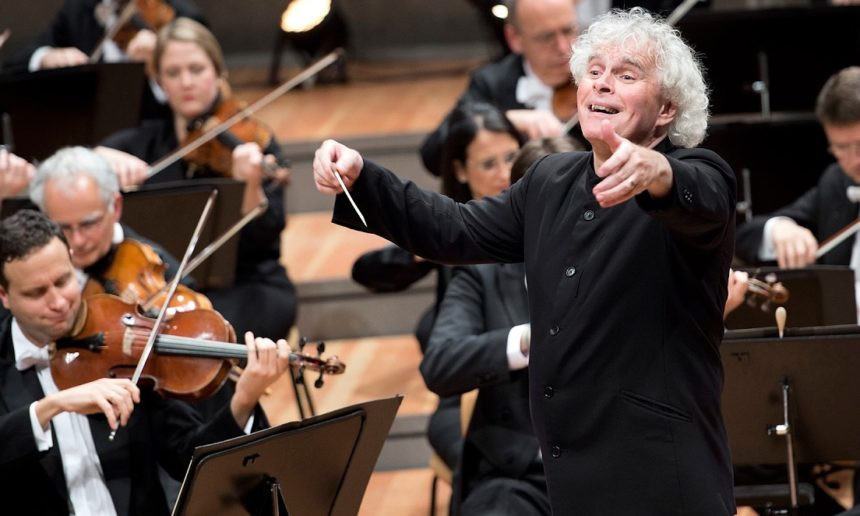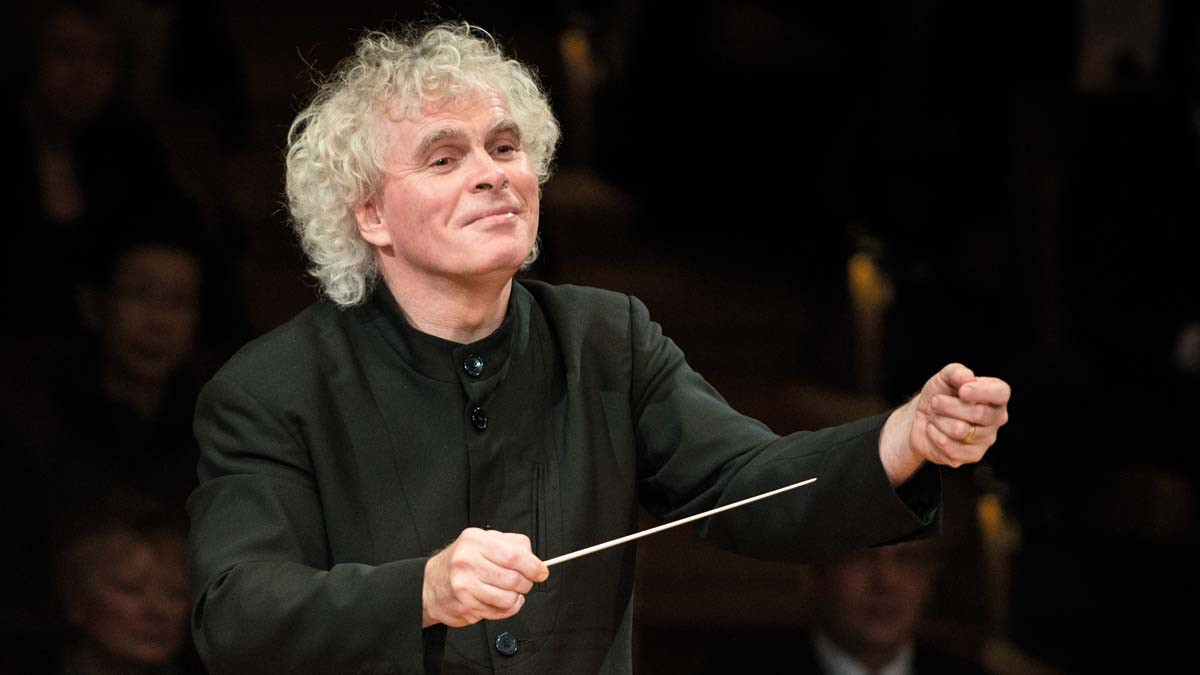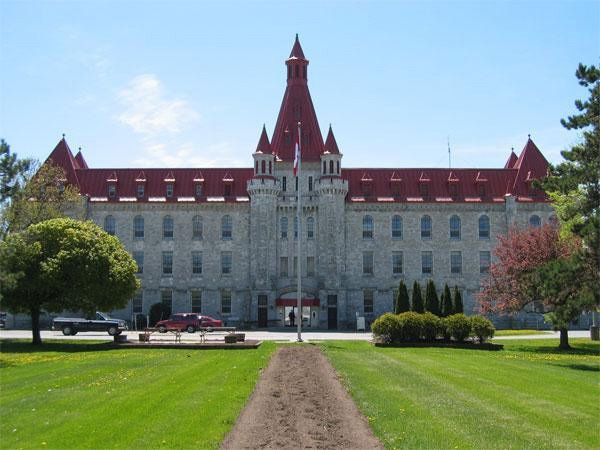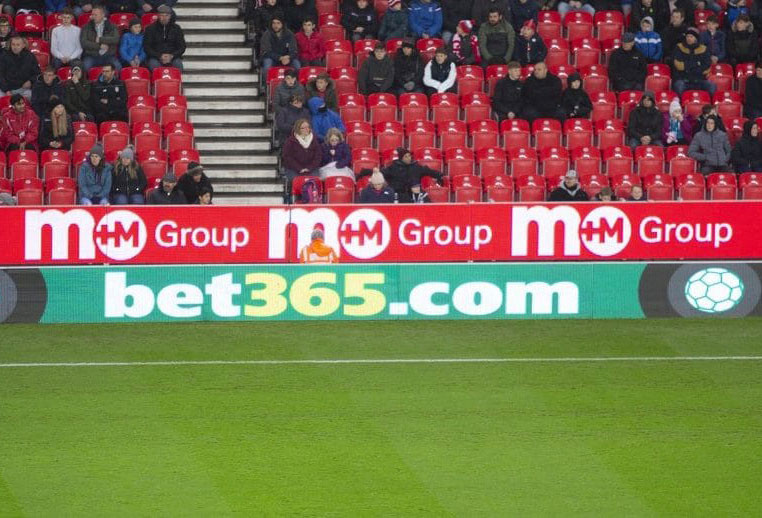Aquifer, here receiving its UK premiere, takes its name from an underground layer of permeable rock through which water seeps and flows. Adès’s music duly oozes and gushes, with string lines that echo waveforms, brass tectonics that slither and slide, and woodwind that seems to bubble up through the cracks.
Rattle unerringly located the music’s sweet spot, teasing out its effervescent hues – like the propulsive opening dappled with tubular bells and vibraphone – and honing its climaxes. It can be urgent, but it can be jaunty too, with a recurring horn theme that John Williams might be proud to call his own. One thing that’s certain, though, it’s seldom still. And for all the surface flamboyance, it’s a rich, rewarding and thoroughly mature work that feels tantalisingly familiar even when it’s being entirely novel.
Performances of Bruckner symphonies can sometimes feel predictable, the only question being just how loud and drawn-out do you like your climaxes? Not here. Rattle has peered deeply into the score of the “Romantic” Fourth Symphony and discovered something fresh and new. The result was an interpretation that was light on its feet and imbued with a grace and lucidity rarely associated with this composer.
Instead of channelling Wagner, whose influence looms over Bruckner’s Third Symphony, Rattle brought out the Brahms in the Austrian composer’s music, his knack for orchestral balance and musical storytelling impeccable. The orchestra was elegance personified, their elfin touch sending shivers up the spine in what must be some of the most daring pianissimos ever heard in the Albert Hall, let alone in a Bruckner symphony. And yet the tension never flagged in a truly remarkable performance that held the audience spellbound.
You may, quite understandably, be unclear as to the exact meaning of Aquifer, the name Thomas Adès has given his stunning new work for the Bavarian Radio Symphony Orchestra, which it brought to the Proms under Simon Rattle. So was I, until by one of those odd coincidences I found it explained just a few yards away from the scene of the Proms, in Kensington Gardens. There, the flowing Diana Memorial Fountain is powered by water drawn upwards from a chalk aquifer 100 metres below ground: the aquifer is an underground layer of stone which suppresses, holds and releases water.
We can feel sure that any thought of Diana was a million miles from Adès’s imagination as he conceived his titanic piece, for what he has drawn here is a massive picture of the earth struggling to unlock its resources, a constant tension of repression and release which is coloured in the most vivid orchestral sounds. It shows Adès as an unrivalled master of large instrumental forces, and especially in the complexity and overlapping of its different elements it grips the attention constantly. In a completely different harmonic idiom, I could think only of Harrison Birtwistle’s superb Earth Dances of 1986 as a comparator, and Adès is the more immediate for listeners.
Here a wind chorale, here haunting unison strings, here blasting brass, here half a melody, veering between extremes of dynamics as you sense the accumulation of intensity and the struggle for movement. From the perfectly paced to-and-fro of tension across 20 minutes, the final section of upward-springing eruption is a tremendous release. But I do not think you necessarily need to hear this as all about water (in the way you surely have to with Debussy’s La mer, for instance): it can equally be a portrait of a deep emotional journey, a cinematic picture of the twists and turns of a life. This is a piece that boldly demonstrates the continued purpose and richness of the symphony orchestra as a creative force, and it will surely be taken up by ensembles around the world.
The score posed no terrors for the Bavarian players and Rattle, who has personally championed Adès’s music since premiering Asyla back in 1997, and who after this performance presented the composer onstage with the gold medal of the Royal Philharmonic Society. This was the orchestra’s first appearance here since Rattle took over as chief conductor last year, and the signs are very good: Bruckner’s Fourth Symphony emerged as a gloriously expansive and warm-hearted sound-world, led throughout by a stellar brass section with peerless horns.
The symphony was allowed to unfold without any of the oppressive hectoring that can dominate Bruckner, the interior lament of the Andante perfectly matched by the incisive forward movement of the Scherzo. The sinister tread of the double basses in the finale unleashed a tumult of sound, but one that remained always rounded, sculpted, and deeply humane.
The last time I spoke to Thomas Adès was on a dark and wintry day in central London. The composer, whose work has graced the stages of the Royal Opera House in London and the Met in New York, arrived late and on a motorbike, and at first I mistook him for a courier coming over to ask directions. His explanation of his lateness was unimpeachable. He had come from a meeting at Faber & Faber, his publisher, where he was introduced to Edna O’Brien, whose magnetism held him spellbound.
Talking to him now, he says of the late writer, “I just remember that it was rather like meeting someone from legend. She was an extraordinary person, of course, and it was extraordinary how beautiful she was. Not just beautiful looking. She had a visionary quality. It somehow wasn’t like meeting another brilliant or interesting person. It was something else. It’s like a mythical quality she had.”
I’m talking to Adès about his new orchestral work, Aquifer, a commission to mark the opening of Simon Rattle’s tenure as chief conductor of the Bavarian Radio Symphony Orchestra. Rattle and the orchestra give the Irish premiere of the work at the National Concert Hall next weekend in tandem with a performance of Bruckner’s Fourth Symphony.
Adès calls the new work “a one-movement symphony with a small S”. “It’s one of a handful of works I’ve been doing in the last few years in which I found they wanted to get to C major or some such thing by whatever means possible. And the image of the aquifer, I actually got this wrong. I always liked the word, and I thought it would be a very good title. But I slightly misunderstood what an aquifer was until I started writing the piece and actually looked it up.
“I thought of it,” he explains, “as somewhere where the water comes out into our world, if you like. But it’s actually something more specific still. It’s whatever geological feature water chooses or finds to carry it. It might be just a sort of natural runnel in the rock. I’m even happier with that as an image for the piece. I think it’s even closer to what I was thinking.”
The way Adès thinks of himself, he says, is as someone who’s “really making structures that to me are ideally as firm and solid as rocks, something that is there, that’s fixed. And the water in this case is that mysterious thing that music is, that sort of force or energy that it is.
“So my role is to make exactly a channel for it. And that channel will be, I hope, like a natural one. So it’s not a kind of right-angled concrete thing. It’s got nobbles and eddies and strange, surprising turns of direction, as nature often does. It’s always exciting to find a natural spring somewhere. And just this thought that it’s been carried there from somewhere by some natural force. That’s how I think of composing in a way, of my role in the world.”
Adès describes himself as trying to “understand the natural processes in these notes and chords and things. I believe with a sort of primitive faith that they do have a natural weight and energy of some kind and that nobody really quite understands how it works. Who says that C has to follow G? And yet these energies are still there to me. So my role is to make the form to cut and to carry that.”
The title didn’t come at the beginning. “I think I was trying out all sorts of fancy titles to do with wells and springs and sources. But all of those words had so many other meanings that it was terribly confusing. I’ve got to be as specific as possible. One day ‘aquifer’ just suddenly popped up on the page. And that was that.”
How did the piece get started? “There was this image of the piece that finds its way to C major. There were a few versions of that. One was some songs, then there was a string quintet. This one came just before the string quintet.”
He pivots, mid-thought, to talk of tidying up “a lot of old boxes the other day, basically all my work and pieces. First of all, I was quite horrified how many of them there were. I’d run out of space basically. But then, looking at them all to put them in some kind of order, I realised that in every piece there were about six or seven or eight page ones. And then it sort of narrows down.
“So I often take several false starts – sometimes much more than that, actually. That’s the way the thing gets off the ground. What happens is then there’s one form of it that leads to a page two. That was the case with Aquifer. I think it really is like trying to light a match, or some kind of chemical experiment where it doesn’t work and doesn’t work, and then suddenly it does.”
I mention the rule of thumb about writers needing to cut their first paragraph(s), as they often turn out to be a kind of clearing of the throat. “It could be that,” Adès says. “I’m very interested in music in introductions, in classical works. In Schubert’s Unfinished Symphony you’ve got those opening eight bars and it’s somehow exactly proportionate to the scale of the whole thing.
“Why do we have it? It’s usually to put you in a particular atmosphere or space. For me it’s rather like waking up. You know, one can kind of wake up with an alarm call at the start. That’s one way. Then there’s that thing of kind of slowly remembering who and where you are. In Aquifer I think of it rather cinematically. It’s like you’re underground in the darkness, but moving very quickly. And suddenly, you’re like, oh, we’re in a stream of water.
“In retrospect, once I found that page two I really enjoyed writing this piece. Because, if you’re writing about the course of water, you can trust quite a lot in where it’s going to swell, where it’s going to take you.”
Adès doesn’t like to distinguish between abstract and programme music; he brings up Smetana’s Vitava, “one of my favourite symphonic poems”. The piece, named after the longest river in the Czech Republic, is part of a cycle composed in the 1870s under the title Má Vlast, or My Country.
The opening depicts the gentle movement at the river’s source through a stream of rapid, soft flute writing, with the rolling material swapped almost imperceptibly between players. “I just think that’s magic,” he says. “It’s so evocative. I like the whole set; they’re almost my favourite orchestral music.”
In the same breath he talks about Mendelssohn’s spray-filled Fingal’s Cave Overture, the one more commonly known as The Hebrides. “It’s just a sort of perfect symphonic movement, and it could not be more evocative of that place. My piece is a kind of tiny footnote to that sort of work, that way of thinking.”
Oh, and if you’ve heard that Rattle, who began life as a percussionist, played a rattle at the end of the world premiere, don’t be expecting to hear him do it again in Dublin. It wasn’t any kind of Haydnesque witticism. Adès simply miscalculated the number of hands available to him in the percussion section. The rattling is now taken on by one of the orchestra’s non-percussion players.


















